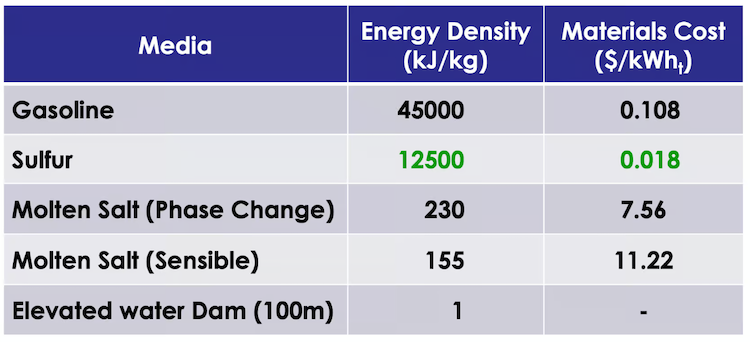A solar sulphur cycle to make unlimited thermal energy storage

Sulfur can be stored like a pile of coal. “This cycle allows you to get energy out of the sulphur and store it in between. Why it’s in focus now is that we can use 100% renewable energy – concentrated solar – to heat the reaction. That’s why chemical companies now come in and are interested in demonstrating the plant.”
Researchers are now refining a groundbreaking long-duration thermal energy storage technology in the SUPHURREAL project
Molten salts are currently state-of-the-art for solar thermal energy storage. But elemental sulphur has more than an order of magnitude greater energy storage capacity, and is ideally suited to seasonal thermal energy storage, DLR Institute of Future Fuels research head Christian Sattler noted in a call from Germany.
“Sulphur’s energy density is so much higher than that of molten salt, and also you get high-value heat,” he explained. “You have a very cheap storage medium in the sulphur, and since we propose chemical combustion, you can adjust the temperature to whatever temperature level you need.”

Sulphur energy density / cost compared ©Allothermally Heated Reactors for Solar-Powered Implementation of Sulphur-Based Thermochemical Cycles
Most thermal energy storage materials aren’t combusted when used for heat. Sulphur is different. Like a pile of coal, sulphur would be stored in a pile outside, and then, like coal, it is burned when the heat is needed.
But there’s a huge difference between burning coal and burning sulphur. Imagine if when you burnt a lump of coal, a new lump of coal was created. In a solar thermochemical sulphur cycle that Sattler’s team has been working on, when you combust the sulphur, you would generate new sulphur to burn again…
How the solar thermochemical cycle makes sulphur renewable
Each time you burn sulphur, it creates sulphur dioxide that can be processed to sulphuric acid, which can be reacted to create sulphur again. So this continuing cycle lends itself to a thermochemical process that endlessly cycles between sulphuric acid and sulphur.
“The sulphur can either be reused in the storage cycle to close the loop, or it can be further processed to produce a surplus of sulphuric acid as a valuable commodity,” Sattler said.
“This cycle allows you to get energy out of the sulphur and store it in between. Why it’s in focus now is that we can use 100% renewable energy – concentrated solar – to heat the reaction. That’s why chemical companies now come in and are interested in demonstrating the plant.”
From CORDIS EU Research Results: Sulphur poised to transform the future of solar energy storage
“During this cycle, the sulfur is collected to form a pile, and the H2SO4 is stored in suitable tanks. When the sun is shining, the sulfur pile grows while the H2SO4 tank is emptied. During the night or when it is cloudy, the sulfur pile reduces [as some is burned, generating H2SO4] so the H2SO4 tank fills up”:
And then, because sulphur can be stored in a pile in ambient air, and is not affected by rain, sulphur is just as available as coal was, but with no CO2 emissions, and renewable, due to this thermochemical cycle.
Why a sulphur thermochemical cycle is relevant now: Solar heat
Today’s concentrated solar thermal can generate very high-temperature heat from its solar field of heliostats. Particle receivers like DLR’s CentRec® can translate the reflected solar flux into temperatures over 1000°C. Synhelion’s gas-based receiver gets even hotter; 1500°C. This means concentrated solar thermal can now run many thermochemistry processes that used to require the burning of fossil fuel.
The first heating step of the sulphur cycle uses heat in the 450-500°C range when sulphuric acid is dissociated into steam and sulphur trioxide (SO3). The second step uses between 700-950°C for catalytic dissociation to sulphur dioxide (SO2) and oxygen.
Sulphur cycles were already known. In response to the oil shocks of the 1970s, General Atomics had proposed using the hybrid sulphur cycle but tapping nuclear power rather than concentrated solar for the heat, to generate hydrogen and sulphuric acid. However, that idea was shelved once the fossil fuel industry regained hegemony, and since that time, hydrogen has been produced from steam reforming of natural gas.
But in today’s more climate-conscious world, green production of hydrogen is back in focus, along with the resulting need for renewable energy to provide seasonal energy storage to guarantee continuous chemical processes like this solar sulphur storage cycle.
Sulphur’s advantages (for both green hydrogen and seasonal storage) are its low cost, high energy density, wide availability and that it’s easily shipped by truck, rail or ship…
Read More: A solar sulphur cycle to make unlimited thermal energy storage

